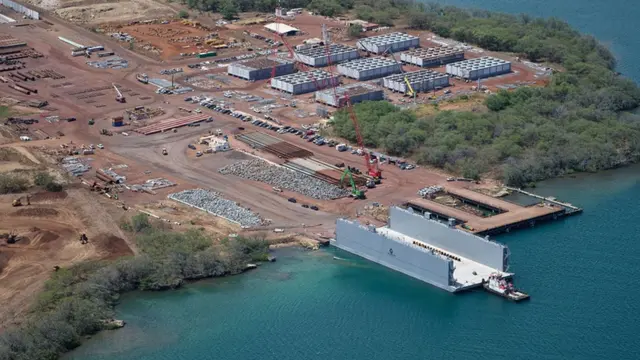
The US Navy’s newest dry dock at Pearl Harbor is taking shape as the centerpiece of a $3.4 billion project to expand the shipyard’s ability to maintain nuclear-powered submarines in the Pacific, a region where Washington faces an increasingly capable Chinese navy, Interesting Engineering reports.
Photos released this week by Pearl Harbor Naval Shipyard show cranes, steel framing, and concrete work underway on the massive Dry Dock 5.
The structure, already more than one-third complete, is designed to handle Virginia-class attack submarines and larger surface vessels that the shipyard’s smaller, decades-old facilities cannot fully accommodate. Completion is scheduled for 2027.
Pearl Harbor’s WWII dock
Shipyard officials described the project as more than just an infrastructure upgrade. “Dry Dock 5 is more than just steel and concrete; it’s a commitment to the future of naval readiness,” the shipyard said in a social media post.
The dock will be 657 feet long, large enough to berth the Navy’s newest fast-attack submarines, and built to last 150 years.
A dry dock is essentially a three-sided basin used to service a ship’s hull. After a vessel is floated in and the entrance sealed, water is pumped out, leaving the ship supported on blocks for maintenance. When repairs are finished, the basin is re-flooded so the vessel can exit.
Dry Dock 5 is being built next to the much smaller Dry Dock 3, a 497-foot structure constructed during World War II.
The Navy said Dry Dock 3 lacks the size and floor strength to support Virginia-class submarines and will become functionally obsolete as older Los Angeles-class attack submarines retire.
By contrast, the new dock will meet projected maintenance requirements for decades.
Pearl Harbor Naval Shipyard, part of Joint Base Pearl Harbor-Hickam, is one of only four public shipyards the Navy operates.
All were built in the 19th or early 20th centuries and are responsible for operationalizing the fleet’s nuclear-powered warships. U
Under the Navy’s Shipyard Infrastructure Optimization Program, or SIOP, the service modernizes dry docks, replaces outdated equipment, and reconfigures yards to increase the throughput of submarines and carriers.
Most advanced nuclear submarines
The push for more capacity comes as China fields the world’s largest navy by hull count and rapidly expands its shipbuilding sector.
US officials say at least 35 Chinese shipyards are linked to Beijing’s military or national security projects.
By comparison, the Navy’s four public yards at Pearl Harbor, Portsmouth, Norfolk, and Puget Sound handle most of America’s nuclear-powered fleet maintenance.
Pearl Harbor’s location on the central Pacific island chain that stretches from Alaska to New Zealand makes it a key hub for US submarine operations.
Both Virginia- and Los Angeles-class attack submarines are homeported there. The next-generation Virginia class is 377 feet long with a displacement of 7,800 tons; the Los Angeles class, first deployed in 1976, measures 360 feet and displaces 6,900 tons.
When Dry Dock 5 opens, Navy planners say it will strengthen America’s ability to sustain its forward-deployed submarine force at a time of intensifying competition with China.



